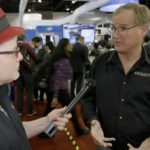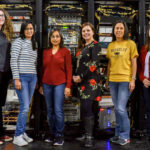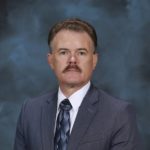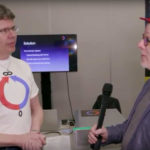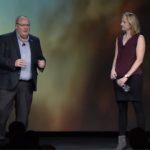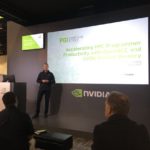Today Asetek announced an order from Fujitsu, an established global data center OEM, for a new High Performance Computing system at a currently undisclosed location in Japan. This major installation will be implemented using Asetek’s RackCDU liquid cooling solution throughout the cluster which includes 1300 Direct-to-Chip (D2C) coolers for the cluster’s compute nodes. “We are pleased to see the continuing success of Fujitsu using Asetek’s technology in large HPC clusters around the world,” said André Sloth Eriksen, CEO and founder of Asetek.
Mid-career Women help build SCinet with WINS Apprenticeship at SC17
In this special guest feature, Alisa Alering from ScienceNode writes that a team of women engineers helped build SCinet as part of the WINS program at SC17. “A lot of these women come from small schools, and they may not normally get exposed to the technology SCinet provides,” says Meehl. “It’s a great experience technically, but they also get a great professional experience meeting people—that really brings value to your ability to do your job.”
The Mont-Blanc project: Updates from the Barcelona Supercomputing Center
Filippo Mantovani from BSC gave this talk at the GoingARM workshop at SC17. “Since 2011, Mont-Blanc has pushed the adoption of Arm technology in High Performance Computing, deploying Arm-based prototypes, enhancing system software ecosystem and projecting performance of current systems for developing new, more powerful and less power hungry HPC computing platforms based on Arm SoC. In this talk, Filippo introduces the last Mont-Blanc system, called Dibona, designed and integrated by the coordinator and industrial partner of the project, Bull/ATOS.”
D-Wave Completes Prototype of Next-Gen Quantum Processor
Today D-Wave Systems announced that the company has completed fabrication and testing of a working prototype next-generation processor, and the installation of a D-Wave 2000Q system for a customer. The prototype processor uses an advanced new architecture that will be the basis for D-Wave’s next-generation quantum processor. The D-Wave 2000Q system, the fourth generation of commercial products delivered by D-Wave, was installed at the Quantum Artificial Intelligence Lab run by Google, NASA, and Universities Space Research Association.
Application Readiness Projects for the Summit Supercomputer Architecture
Dr. Tjerk P. Straatsma from ORNL gave this talk at SC17. “The Center for Accelerated Application Readiness (CAAR) projects are using an Early Access Power8+/Pascal system named SummitDev to prepare for the Power9/Volta system Summit. This presentation highlights achievements on this system, and the experience of the teams that will be a valuable resource for other development teams.”
Video: Inside Volta GPUs
Stephen Jones from NVIDIA gave this talk at SC17. “The NVIDIA Volta architecture powers the world’s most advanced data center GPU for AI, HPC, and Graphics. Features like Independent Thread Scheduling and game-changing Tensor Cores enable Volta to simultaneously deliver the fastest and most accessible performance of any comparable processor. Join us for a tour of the features that will make Volta the platform for your next innovation in AI and HPC supercomputing.”
A New Way of Supercomputing with Posit Research
In this video from Disruptive Technologies exhibit at SC17, Theodore Omtzigt describes the mission of a new Startup called Posit Research. “Posit Research is a fabless semi designing and marketing posit-based computational solutions for the artificial intelligence and high-performance computing markets. We are creating a new type of artificial intelligence supercomputer that adapts to the application. It uses a new number system called posit.”
Unstructured-Grid CFD Algorithms at NASA on Volta GPUs
Eric Nielsen from NASA gave this talk at SC17 in Denver. “In the field of computational fluid dynamics, the Navier-Stokes equations are often solved using an unstructured-grid approach to accommodate geometric complexity. Furthermore, turbulent flows encountered in aerospace applications generally require highly anisotropic meshes, driving the need for implicit solution methodologies to efficiently solve the discrete equations. To prepare NASA Langley Research Center’s FUN3D CFD solver for the future HPC landscape, we port two representative kernels to NVIDIA Pascal and Volta GPUs and present performance comparisons with a common multi-core CPU benchmark.”
SC17 Keynote Looks at the SKA Telescope: Life, the Universe, and Computing
In this special guest feature, Robert Roe reports from the SC17 conference keynote. “Philip Diamond, director general of SKA and Rosie Bolton, SKA regional centre project scientist and project scientist for the international engineering consortium designing the high performance computing systems used in the project, took to the stage to highlight the huge requirements for computation and data processing required by the SKA project.”
Accelerating HPC Programmer Productivity with OpenACC and CUDA Unified Memory
Doug Miles from NVIDIA gave this talk at SC17. “CUDA Unified Memory for NVIDIA Tesla GPUs offers programmers a unified view of memory on GPU-accelerated compute nodes. The CPUs can access GPU high-bandwidth memory directly, the GPUs can access CPU main memory directly, and memory pages migrate automatically between the two when the CUDA Unified Memory manager determines it is performance-profitable. PGI OpenACC compilers now leverage this capability on allocatable data to dramatically simplify parallelization and incremental optimization of HPC applications for GPUs.”

